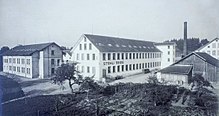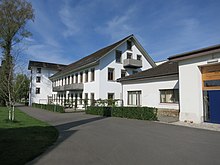Stehli silks
The Stehli Seiden AG was in 1837 in the hamlet Oberlunnern the community Ottenbach (from 1847 Obfelden ) in Canton Zurich founded and introduced silks ago. The American subsidiary founded in Lancaster , Pennsylvania in 1897 was one of the world's largest silk weavers at the time.
history
The Stehli family received Zurich citizenship in 1490 and exercised the subordinate bailiff of Maschwanden in the 16th and 17th centuries .
Rudolf Stehli-Hausherr (1816–1884), merchant and wine merchant (later district governor, cantonal councilor, constitutional councilor and national councilor), founded a weaving mill in 1837 and produced cotton fabrics. In 1840 he started silk weaving on 30 handlooms. In 1845 the first jacquard hand loom for umbrella fabrics was set up, and in 1879 a jacquard weaving mill was set up in Bremgarten , which was later abandoned in favor of the cheaper mechanical jacquard weaving mill.
In 1870 300 weavers worked in silk weaving. They brought their list ( warp beams ) and the weft in the Ferggerei from. Working at home in their farmhouse parlors, they woven the desired fabrics and delivered the finished goods. Black, heavy silk satins , light colored taffetas and fragrant, striped gauzes were produced, which fashion houses in Europe, America and later in Asia had fashioned into elegant robes and ties.
In 1871 the company switched to mechanical silk weaving, at the height of which more than 2000 workers were employed. The first mechanical silk looms were operated with a 10 HP steam engine. The nave and the boiler house were built in 1880, the large shed hall was added in 1886 and the turning shop a year later. In 1891 a branch of the headquarters in Oberarth was opened.
Rudolf Stehli's son Emil Stehli-Hirt expanded the company and expanded abroad. In 1885 he took over the silk weaving mill, founded 45 years earlier by the Swiss Francesco Huber and run by Cesare Bozzotti since 1875, in Germignaga in northern Italy on Lake Maggiore next to Luino . Further production facilities were located in Porto Valtravaglia and Prassede. Emil Stehli-Hirt had the “Villa Stehli” built in Obfelden in 1875–1876 as a summer residence for the family of manufacturers and in 1897 the “Villa Emil Stehli-Hirt” as a city palace in the Italian Renaissance style in Zurich-Seefeld (1956 aluminum house of Alusuisse ).
Emil's son Robert Stehli opened one of the largest silk mills in the world in Lancaster , Pennsylvania in 1897 . She had other factories in High Point (North Carolina, 1902-1935), Waynesboro, Virginia (1925-1941) and Harrisonburg (Virginia) . The Lancaster company peaked in the 1920s when it employed 2,100 workers. It began to decline during the Great Depression and it could not recover. The Lancaster silk factory operated until 1954.
Emil Stehli-Hirt's son-in-law, Max Josef Frölicher-Stehli (1851–1913, partner since 1892, living in the “Villa Riesmatt” Zurich-Seefeld from 1888), was with his wife Margaretha Emerentia (1864–1955) and daughter Hedwig in 1912 (1890–1972) on business trip to Lancaster and was traveling on the RMS Titanic when it collided with an iceberg. You were among the 710 survivors of the shipwreck. After the disaster, the daughter stayed in New York, where she married the Swiss textile industrialist Robert JF Schwarzenbach-Frölicher (1875–1929), who ran the silk import company Schwarzenbach, Huber & Co. , in 1913 .
During the Great Depression in 1929 was in bonndorf a two-story factory building in Shedbauweise created, which was later taken over by the Stump factory Villiger. In the 1930s, the export-dependent textile industry was hit hard by the crisis and the Oberarth silk factory had to close in 1933. In 1937 the Mechanische Seidenstoffweberei AG Adliswil MSA moved its headquarters to Oberarth and continued to operate the Oberarth silk factory under the name Emar AG until 1991.
In May 1945, Director Suter helped the Stehli silk factory in Erzingen (Klettgau) by intervening in the Federal Council to ensure that the village was not evacuated and the population was not expelled by order from the Allied headquarters in Paris.
The company was converted into a stock corporation in 1958 and remained family-owned until the beginning of the 21st century. In 1977 the production of silk fabrics in Switzerland had to be stopped for cost reasons and relocated to Germignaga , Italy, and other neighboring countries. Creation and sales, which were discontinued in 1996, remained in Obfelden.
In the 1990s, production abroad also had to be abandoned. Until the shutdown of the companies in Northern Italy, the silk weaving mills “Setifici Stehli” were run by Robert Stehli. Since then, the company has been managing its properties on the former premises in Obfelden. By 2016, the listed former factory buildings in Obfelden were converted into loft apartments (long house), apartments (instead of the shed hall) and studios.
The former Stehli silk weaving mill in Lancaster has been listed on the National Register of Historic Places . Stehli silk fabrics are in the Metropolitan Museum of Art . The Stehli Seiden collection with material from 175 years of company history is located in the former boiler house at the headquarters in Obfelden .
literature
- Mills of the Stehli Silks Corporation . Verlag Stehli Silks Corp., Lancaster, Pa., 1929.
- R. Stehli-Zweifel: Stehli & Co., Zurich and New York, 1840–1940. Obfelden 1940.
- History of the Obfelden community. 1947.
- HR Schmid: Rudolf Stehli-Hausheer (1816–1884). In: Swiss pioneers in business and technology. 2nd 1955.
- Megan Searing: The Stehli Silk Company Strikes Back - The Americana Series of the 1920s. In: Trans-Lux. Volume 20, Issue I (PDF; 384 kB).
- Erich Gruner : The Swiss Federal Assembly 1848–1920. Volume 1. Francke publishing house, Bern 1966.
- Stehli. Silk Memory, Lucerne University of Applied Sciences.
- Archive fabric. Stories from the Stehli Seiden Collection. 2017. Interviews on the book archive tissue (video; 39 minutes).
- Architectural art. The biography in writing and illustration boards. Loft apartments Obfelden (PDF; 308 kB).
Web links
- Katja Hürlimann: Stehli. In: Historical Lexicon of Switzerland .
- Susanne Peter-Kubli: Rudolf Stehli. In: Historical Lexicon of Switzerland .
- Tim Buckwalter: See 1920s photos of the Stehli Silk Mill. In: Lancaster Online. April 26, 2016 (photos of the Stehli silk factory from the 1920s)
- Tim Mekeel: Stehli Silk Mill developer seeks buyer or partner. In: Lancaster Online. April 25, 2016 (with video)
- Silk industry in annual journal Argovia of the Historical Society of the Canton. Aargau. Volume 101, 1989.
Individual evidence
- ^ Barbara E. Taylor: Images of America, High Point. Arcadia Publishing, Charleston SC 2013, ISBN 978-0-7385-9929-8
- ↑ Elizabeth Spilman Massie, Cortney Skinner: Images of America, Waynesboro. Arcadia Publishing, Charleston SC 2009, ISBN 978-0-7385-6809-6
- ↑ In gratitude, twenty lire in gold. Industrialists Max and Marguerite Frölicher-Stehli from Obfelden were among the Titanic survivors. In: Anzeiger from the Affoltern district. April 11, 2012
- ↑ The Studer building is flattened. In: Badische Zeitung . 11th September 2013
- ↑ Old silk factory. An address with history. Tram path, old silk factory in Oberarth
- ↑ Kulturspur Oberath. O 8 factory building. Website of the parish of Arth
- ^ History. Stehli Silk Area
- ↑ Stehli-Areal: The Shedhalle has to give way. In: Anzeiger from the Affoltern district. June 22, 2012
- ↑ 38 modern rental apartments instead of the shed hall. In: Anzeiger from the Affoltern district. January 27, 2015
- ↑ Stehli Silk Mill Lancaster. National Register of Historic Places (PDF; 16 MB)
- ^ For design for new textile patterns. Stehli Silks Corporation. Metropolitan Museum of Art
- ^ Edward Steichen : Sugar Cubes: Design for Stehli Silk Corporation. Metropolitan Museum of Art
- ^ Stories from the Stehli Seiden Collection. Stehli Silk Area. In 2017 the company archive in the State Archives of the Canton of Zurich was indexed.
Coordinates: 47 ° 15 '45 " N , 8 ° 25' 4.6" E ; CH1903: 674,117 / two hundred thirty-five thousand and eighty-three



